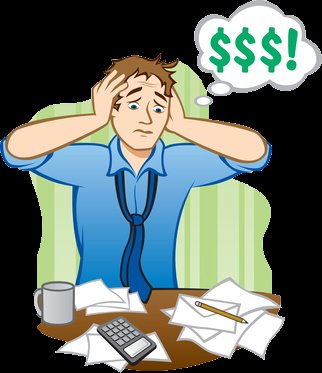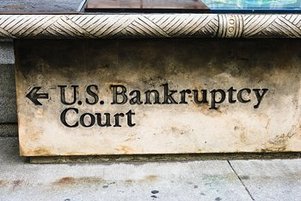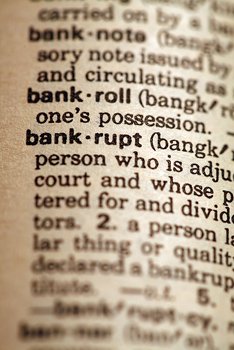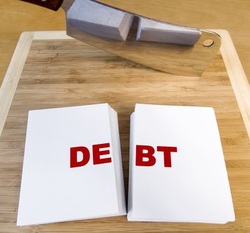 Medical debt is another type of credit that most people are burdened with. Health care is not cheap and the rising costs to treat an illness can put anyone in debt. In truth, being in debt is not always because of bad spending habits. Some people made all the right choices in terms of their finances. However, when tragedy struck, it turned out that they lacked in one area: saving. As any doctor will tell you, prevention is better than cure and the same can be applied even to your finances. Instead of putting yourself in debt when a significant amount is immediately required, you have this financial net to fall back on. This is especially true for those who are suddenly faced with a medical emergency. It can be quite stressful when you know that you do not have the money to finance your treatments. But that can be solved or averted if you only learn how to save up for it. You can invest in a health coverage or insurance so you have something to use when you or a family member contracts an illness. Medical debt is a serious problem that Americans are facing today and while saving is one way to solve or prevent it, there is another option. If you find yourself deep in medical debt and you still think you will incur more, here are a couple of options that is available for you. One of them is debt settlement. While debt management can help with this, it usually requires you to stop incurring debt. If this is not possible because you are still undergoing treatments, debt settlement can be a viable option. You can use your medical condition to prove that you are in a financial crisis and you need help through debt reduction. You can send a letter to your creditor, discussing why you are late on your payments and indicate that you are open to discuss how you can still make payments despite your limited resources. Negotiate to pay only a percentage of your current balance and have the rest of your debt forgiven. You can also look for government backed aids to help you make ends meet as you continue to incur medical debt. Research on the Internet for charitable organizations who can help with the type of illness that you have. They can give you medical aid in the form of free consultations and medical services. They can also provide you with financial support and even medicines. There are also cheaper alternatives in terms of health care. This will minimize the chances of you putting yourself in debt. Research and ask for various alternatives to heal any ailments that you may have. Also, make sure that every billing statement that you get is carefully scrutinized. There are times wherein people are billed for services and medication that they did not get. Check the quantity and question any entry that you do not understand. This will ensure that you will only be paying for what you received. More than anything, saving is still the best way to solve your medical debt problems. Not only that knowledge will be your greatest ally so make sure you are aware of your options.
 What do you do when your income is not enough to cover both your basic needs and your debt payments? Do you run away from all your problems and give up? Although you may feel like giving up and just run away from all your debt problems, you need to face the mess that you made. Ignoring your debts will not make things better too. This is one problem that you need to act on to be able to solve it. If your income is not enough to cover your basic expenses and all your debts, one of them will have to change. It’s either you increase your income, you lessen your expenses or your reduce your debts. For some people, the first two is their first option. But then again, what if you did both and it is still not enough? Fortunately, there are debt reduction options for people who need it: debt settlement and bankruptcy. The first option is debt settlement. Of the two, this is the more prominent option in terms of debt reduction. The fact is it does not have that much negative effect on the debtor’s credit score - unlike bankruptcy. You will begin by telling your creditor that you are in a financial crisis. To prove this, you will deliberately default on your payments. Instead of sending the amount to your creditors, you will place it in a separate account where you will grow it to be your settlement fund. This is what you will offer your creditors. When the 6th month or so comes in, a collector will take over and will be more aggressive in their efforts to get you to pay. The key to sway the creditor/collector to agree to settle is by telling them that you are on the brink of bankruptcy. Creditors, especially credit card companies are among the last to be given anything when a debtor files for bankruptcy. So you can very well expect that they will be hesitant to go to bankruptcy. If they agree to your request, you will pay the settlement amount and the rest of your debts will be forgiven. Your score will suffer because of the deliberate defaulting on payments. While there is a significant debt reduction, there are instances wherein people opt to avail of bankruptcy instead of debt settlement. This is despite the credit score implications that are the worst among all the other debt relief options. This is when they don’t even have enough to pay for the settlement fund. There are two ways for it to go: Chapter 7 and Chapter 13. The first is the option that most people want to get because it leads to the complete discharge of their debts. If you have any valuable asset, the court will decide which should be liquidated and distributed to your creditors. Anything that cannot be covered will be forgiven and no one will come after you again for it. Chapter 13 is similar to debt settlement because there is a repayment plan that the court will order you to complete. Once this is fulfilled, the rest of the debt will be forgiven. The court will decide which bankruptcy you will file depending on the means test. For instance, if your salary is above the median range in the State where you filed bankruptcy, then your chances of filing for Chapter 13 is high. These options will get you out of debt in 4 years or less. If this is your only option, do not worry too much about your credit score. While it will be destroyed, the important thing is to get out of debt. You can always rebuild your credit score. Just make sure that you will start making smarter financial decisions so that you will stay out of debt for good.
 Debt negotiation is an effective way of getting out of debt. It involves communicating with your creditors so they can accept your proposal to pay for only a portion of your debt and have the rest of it forgiven. Not all creditors will immediately agree to this. Most of them will probably give you a hard time at first. But if you know that it is possible and you use the right techniques, you may get the approval that you need. If everything goes well, you may find yourself out of debt in less than 4 years. However, you need to make sure that you have the right debt first. Debt negotiation or debt settlement is only ideal for certain types of debts. The best debt to apply this option to is your credit card debts. Card companies know that when it gets to bankruptcy, they will be on the least priority. That means, if you have mortgages, any liquidation coming from your personal assets will be sent to them first. The chances of the card companies getting anything is very low. This is why they will be more amenable to agree to your settlement offer. This is also true for other unsecured debts like those from store cards and personal loans that you have. Secured loans like mortgages and car loans will not work because you cannot negotiate to settle without putting your collateral on the line. The best that you can do is to ask for a loan modification or a home refinancing. Debt consolidation may be the better debt relief option for you at this point. For student loans, they are neither affected by bankruptcy or debt settlement so you really have no choice but to seek for government aid to get help. There are programs that will help reduce your loan amount - specifically the monthly payment dues. This way, it will be easier for you to meet your payments and spend for other important things in your life. If you are in a real financial crisis, you can even have your debt completely cancelled. But this is something that you need to be qualified for. It is important to remember that all debt situations are unique and you cannot expect that all of them will be solved by debt settlement. But if you think that your credit problems can be dealt with through this option, then here are some tips that you may want to use. First of all, keep mentioning that if your creditor will not lower your payments, you have no other option but to file for bankruptcy. If you are talking to credit card card companies, you know that they will be the first to be discharged so they will receive nothing from you. Settling will be their best option. When you are negotiating for the amount that you will settle, aim for more than 50% off on your current balance. Or if you have a settlement fund set aside, aim much lower than that so you have enough room to negotiate without falling short. Lastly, put everything in writing. There is no one else to do this but you. In case you come into an agreement, never send any payment unless the creditor sent you a written agreement that states everything that you discussed.
 Before you can actually choose the type of debt relief that you will use for your credit problems, it is a wise move to know what you can afford to pay first. While financial analysis is not always a requirement, it should be practiced nevertheless at the beginning of any debt relief effort. You have to start taking charge of your finances not just to grow your debt payment fund but also to make sure you stay out of it. As you make a personal financial analysis prior to debt relief, there are only three categories that you can fall into. Financial Capability 1: With enough money to spend on basic necessities and debt payments. This is probably the luckiest among the three categories. This means the financial capability of the debtor is big enough to cover their daily needs plus the minimum payments of their various credit accounts. While it is fortunate that your income is enough to cover all your financial obligations, you will not be qualified for any debt reduction. You are technically not in a financial crisis even though your debts have spiraled out of proportion. In this case, your debt relief choice is debt consolidation. You can actually try to pay off your debts using the traditional way. This will ensure that your credit score will not suffer as you get out of debt. But if you still want to opt for either of the two types of debt consolidation, debt management or debt consolidation loans, then you may be qualified to do so. In both cases, the debtor will benefit from lower monthly dues because their payment term will be stretched over a longer period. While this has a negative impact on the credit score, it will only be minimal and it will improve as soon as the debtor starts paying off their debt. Financial Capability 2: With money for basic necessities but not enough for debt payments.In the next category, the scenario is not as good as the first. In this case, the debtor does have enough to cover their basic necessities but lacks funds for debt payments. In most cases, people under this category has a steady income but unfortunately, it is not enough to cover for everything that they need. If the deficit for debt payments is only minimal, the debtor can try to increase their income or lower their expenses so be able to afford the options provided in the previous scenario. But if the needed funds are too big, the option for debt relief is debt settlement. Under this program, the debtor will negotiate with the creditor for a settlement amount that is lower than the balance of the debt. If they agree, the debtor will pay for that amount and the rest of the debt is forgiven. The drawback for this is the negative impact on the credit score and the tax implications on the forgiven amount. However, the savings can be significant so a lot of people proceed despite the consequences. Financial Capability 3: With barely enough to pay for basic necessities and no funds for debt payments.This is the worst scenario for anyone. In most cases, people under this category have low paying jobs or even none at all. This type of financial situation means they are living on a tight budget and they has to make changes in their lifestyle just to survive. Usually, there is nothing left to pay for credit obligations. The only debt relief option for this situation is bankruptcy. The debtor will have to go through a means test that will determine if they are eligible for Chapter 7 or Chapter 13. In the former, their debts are totally discharged - but only after valuable assets have been liquidated. In the latter, they are subjected to a low repayment plan which when completed, will prompt the discharge of any balance on their credit. This is probably the worst option for anyone because of the severe impact on the credit score. Consider carefully where your current finances belong to before you decide on a debt relief program. That way, you can choose the best option that your finances can handle.
 Want to settle your own credit card debt? That is possible. While the norm is to hire a debt expert or a lawyer to help out in debt settlement, there are some brave souls who decided to work on this alone. After all, hiring professionals will entail an average service fee of 25% of the total debt or settlement amount. While the savings may be a good enough reason not to hire a professional, you need to know that negotiating with creditors can be frustrating and intimidating. This is most true when you are already dealing with third party collectors. Creditors are still somewhat concerned about their relationship with you as a consumer because after all, they still need you as a returning client. On the other hand, collectors are strictly in the business of going after defaulting debtors. They do not care about customer relationships. If you think that you can handle the stress and you have the negotiation skills, here are the steps you need to follow when conducting your own debt settlement. First of all, stop paying your creditors. You want them to think that you are in a financial crisis and one way to show that is by defaulting on your payments deliberately. That does not mean you will spend that amount on anything. You need to put that aside, preferably in a separate account, where you will grow it as your settlement fund. You will use this later on as a bargaining chip to get your creditor to agree on a settlement. As the months go by without any payment from you, creditors will start calling. This is usually after the first 30 days since your last payment. At first, they will be polite as they ask you to pay your dues. But as it gets longer, they will become more aggressive and even harassing. When a few months have passed, the credit card company will pass your account to a collector. This is when things will get uglier. You will find yourself threatened and this is where some people start to break. Collectors will use all means possible to force you to pay. They will even threaten you with a lawsuit or jail time. As the calls become nastier, you should keep your cool. Ignore the threats and read about your rights as a consumer. You can find out what they are through the Fair Debt Collection Practices Act (FDCPA). Even if the collector threatens you with a lawsuit, they are really hesitant to do that. If you are in a real crisis, the courts may decide to discharge your debts and they can end up with nothing. During your conversation with creditors and collectors, keep mentioning bankruptcy. Tell them that you do not have money and what little you have is barely enough to cover your daily needs. When the 6th month mark comes, start offering to settle. Say that if they do not settle, you may have to file for bankruptcy. Do not be demanding and show hesitation to declare that you are bankrupt. Continue negotiating until you reach a settlement. In some cases the collector will make the first offer to settle. In most cases, the debtor will. There are also times when the collector will not accept your first settlement offer. When that happens, just be patient. The longer it drags, the more likely they will settle with you. When they do agree to settle, make sure you get everything in writing. Never send them payments until you have with you a signed and written copy of the agreement stating that after you pay off the settlement amount, the rest of the debt will be forgiven. Also, make sure that you are settling with an authorized representative. To check that, call the creditor and ask to settle with them. If they direct you to the collector you have been talking to, then they are authorized to settle your debts.
 People who are in debt usually want the quickest way out of it. When we are talking about the fastest way to solve your debt problems, we usually think about bankruptcy. While it can get you out of debt, bankruptcy will not really solve your problems. You may find your debts discharged, but you are far from the financial freedom that should be associated with the elimination of your credit obligations. One of the most prominent (and well advertised) bankruptcy disadvantage is its effect on your credit score. Your score will immediately go down 200 points or more. Not only that, the stigma of bankruptcy will stay in your report for the next 10 years. If you had plans of applying for loan to buy your own home or start up a business, you can say goodbye to that. No lender will come near you to provide you with that financial assistance. If you do find one who will entertain your application, they will most likely give you a high interest rate. Your bankruptcy history will make you a high risk borrower and that results in a higher than the usual interest. Another effect of bankruptcy is you will not learn your lesson. While paying off your debts the traditional way is hard, you get to learn important financial management habits along the way. If your debts are discharged, you don’t get to feel the full impact of your debt responsibility. The chances of you getting back in debt is possible. When you file for bankruptcy, you are also endangering your personal assets. You can end up with a Chapter 7 or a Chapter 13 bankruptcy. With the former, your debts are discharged but if you have valuable assets, the court may request to have them liquidated. If you land on a Chapter 13 bankruptcy, your debts will not be discharged and you will be asked to pay off a portion of your debts through a repayment plan. In this case, you still need to pay your debts and end up with the same credit damage. These are only some of the things that you need to know about bankruptcy. Your financial future will suffer greatly if you file for it. There are debt relief alternatives that can work on your current financial capabilities without the destructive effect on your reputation - at least in the financial world. First option involves growing your income or lowering your expenses so you can increase your debt payment fund. Check your minimum payments and see how much is lacking to cover your debts. Use that as your goal and come up with a plan to reach it. Most of the time, people combine lowering expenses and increasing their income to help grow this fund. If it proves to be a futile effort, choose among debt relief options that will allow lower monthly payments. You can enrol in a debt management program that will stretch your payments to lead to lower payments. You can opt for debt settlement that will involve negotiating with your creditors to agree to a settlement amount. When this amount is paid off, the rest of the debt is forgiven. All of these bankruptcy alternatives may be better but you need to study your finances carefully because there are cases wherein bankruptcy is the only option. Consult a debt expert if you can. You may find their expertise helpful in shedding light to your debt woes.
 If you own a small business, you can expect a couple of debts to haunt you. This is a normal occurrence. From the moment you get a start up loan for the business, you are already in debt. The only difference with consumer debt is that any loan that you take for you business should help pay for itself. Your business generates revenues and any loan you take should be to improve that money making quality. However, there are instances wherein the debt payments can no longer be supported by the revenues. That means you have to start considering debt relief options. There are government programs that you can look into. The great thing about these programs is the fact that you can get lower than the usual interest rates. You can search through Grants.gov to provide you with options on what grants you can avail from the Federal government. These include mostly small business startup loans but they can also provide guarantees for debt assistance loans. Part of the ARRA or American Recovery and Reinvestment Act of 2009 states that tax relief are available for companies who are trying to cut back losses in order to cope with mounting debt. This is something that small business owners may want to look into. Apart from that, it provided over $700 million in funds for SBA loans. You should also know that whatever you can use in consumer debt can be applied in small business too. You can opt for debt consolidation loans or debt settlement. Of course, bankruptcy is also an option but this should be your last resort. All of these small business debt relief options can be effective for certain financial situations. In debt consolidation loans, the idea remains the same - you take out a big loan to cover for your other credit obligations. The idea is to stretch your loan longer so you get to pay smaller monthly payments. As your debt payment becomes smaller, you free up more funds to invest them in campaigns and strategies that will help increase the revenues of your business. Debt settlement is also an option that you can look into. Since a lot of small business entrepreneurs function as sole proprietors, they can qualify either as individual consumers or as a business owner. They get to enroll in a program wherein the debt settlement expert will review the financial capabilities of the business to consider how much it can pay their debts while having enough to cover for the overhead expenses. They will negotiate with the creditors on their behalf so the debt is reduced and the penalty charges are waived off. The last option that small business owners face is bankruptcy. There is a specific chapter known as the Chapter 11 bankruptcy that entrepreneurs can file. It is also known as the Reorganization bankruptcy and it will allow small businesses in debt to get loans with favorable interest rates. These loans will help them stay afloat. It is no longer true that filing for bankruptcy will result in the closure of the company. It is important that you approach bankruptcy carefully as it does pose a significant impact on one’s credit score - specially for sole proprietorship businesses. Consult a bankruptcy lawyer before you proceed so you can identify if this is the best course for you to take. Ultimately, you should know that debt relief is not enough to solve your problem. You need to check your business processes, audit financial books and see through your products and services to determine why your revenues cannot cover both overhead expenses and debt payments. You may have to consider revising some areas in your company to avoid being in the same situation again.
 Before you finalize your debt relief option, you need to know what they are and how they are different from each other. Among the many options, debt settlement and the Chapter 13 bankruptcy is closely related to each other. Debt settlement involves negotiating with creditor to agree to a settlement amount. When this amount is paid off, the rest of the debt is forgiven. If you are wondering how that is similar to bankruptcy, then you need to read on further. You may think that bankruptcy only involves liquidating assets and having the whole debt discharged. That is true, but only for Chapter 7 bankruptcy. Chapter 13 involves a repayment scheme that the debtor will have to pay in order for the rest of their debt discharged. The emergence of this part of the bankruptcy law came at a time when this debt relief was being abused. Now, a means test is in effect wherein the person filing for bankruptcy will be analyzed to see if they qualify for Chapter 7 or Chapter 13. Those who earn above the average median salary of the State will immediately be directed to the latter. The only thing that possibly benefits the filer of Chapter 13 is they are able to protect their assets. By submitting to the repayment scheme, their personal properties are protected from liquidation - something that is not possible in Chapter 7. In both cases, there is a need to be in a real financial crisis to be able to qualify for these two debt relief options. The debtors should also have a high debt to income ratio. In most cases, they have minimal income coming in. Probably the best similarity between the two is that the debtor only pays for a portion of the outstanding balance. After that, the debt is forgiven. The difference lies in a couple of factors. In debt settlement, the whole scheme is dependent on the creditor. In bankruptcy, it depends on the bankruptcy courts. They dictate how much you have to pay and when it has to be paid. It is usually 30% to 50% of the original balance. In bankruptcy, this is more likely to come to pass. In settlement, you are at the mercy of the creditor. Another difference lies in the credit consequences. Bankruptcy is notorious for its effects on one’s credit report. That is not an exaggeration. That taint on your record will remain for the next 10 years and your credit score will go down by a couple of hundred points. In a settlement, the record will be tarnished for only 7 years and the least number of points that you will lose will be around 50 or so. That will be greater the longer you reach a settlement and default on payments. The time frame of the repayment plan will also vary. In bankruptcy, it can stretch to 5 years - making payments smaller every month. In debt settlement, the term is only between 2-4 years. If you want to get out of debt faster, this is will make it happen for you. Privacy is another difference between the two. Your bankruptcy filing will become a public record. Debt settlement remains to be a private matter. The only indication that you went into this debt relief option is in your credit history wherein your debt will be tagged as “settled”. Lastly, the fees are different too. The settlement service fee is dependent on the amount that will be forgiven. The average can reach a high of $5,000. If your debts are high, then the same goes for the fees. Chapter 13 is usually $3,000 tops. Debt settlement is a great bankruptcy alternative but you need to consider which is best for you. Choose which among the two will serve your purpose best. It may help to consider the aftermath of each debt relief option. Whichever appeals to you the most, may be the best debt relief path that you can take.
 When you want to succeed in debt reduction, there are a couple of things that you need to practice in order to maximize your debt relief efforts. Getting out of debt involves more than just paying off what you owe. It also calls for certain changes in your life and new habits to be developed. One of the best practices that must be followed is a partial or complete lifestyle change. The amount of your debts will dictate which is more appropriate. Obviously, there is something wrong with your current lifestyle - that is why your finances have gone all wrong. You need to identify what brought you down and do something about it. Even if you pay off your debts through debt reduction, the chances of you landing in the same situation is more likely to happen if you do not address the root cause of the problem. The reason why you need this lifestyle change, apart from learning your lesson, is to make room for your savings. This is another practice that you have to develop and carry over to your debt free life. Savings can literally save you from a lot of crisis. When someone becomes suddenly ill, you do not have to worry about the costs it will take to have them treated. If you lose your job, your family can survive without you worrying about where to get finances. You are free to concentrate on finding another work to replace what you lost. These are only a few of the scenarios that can benefit greatly from a well planned savings account. If you got used to a life ruled by impulsive buying, that has got to change. In debt reduction, you will create a plan that you have to follow. It comes in two forms: a budget plan and a payment plan. You need to learn how to follow these plans to expedite your debt payments. Not only that, by monitoring your plans, you get to see your progress. As you watch your debts get smaller, you will realize the satisfaction and motivation in knowing that you have taken charge of your credit problems. Ultimately, your budget will teach you a lot of things about living within your means. The great thing about these plans is they will shape your way of living so you do not spend more than what you are really capable of spending. By listing your income and expenses, you get to see where your money is really going and that allows you to identify your wants from your needs. If you have to remove some expenses to help grow your savings or increase your debt payments, you know which ones to remove. Debt is a scary experience but if you get out of it the right way, you will learn valuable lessons that will help you stay out of debt for a very long time. You just have to remember that nothing is impossible if you believe that you can do it. Of course, there are some changes that you need to adapt in order to succeed.
 Any kind of debt relief is effective. However, each of them is suited for a specific type of debt and financial situation. Of all the debt relief programs out there, debt reduction seem to hold the most appeal. The name itself is very promising. But before you can decide that this is the path that you want to take, make sure that you qualify for it. Even if it promises to reduce your debts, you need to have the right financial situation in order to be successful at it. If not, your creditor might not agree to reduce your debts and you can end up with more debt than when you started. Also known as debt settlement, this type of debt relief involves defaulting on your payments. This is one of the ways that you can convince your creditor that you are in a real financial crisis. This is what could put you in deep trouble in case the settlement backfires on you. If you cannot convince the creditor to reduce your debt, you will find yourself with your original debt balance plus the late charges incurred while you defaulted on your payments. This is why you need to make sure you will enter into debt reduction with the right qualifications - so you are sure that your creditor will agree. So what are the qualifications of this type of debt relief? First, you need to possess the right kind of debt. You cannot settle a secured debt. This will mostly depend on the debt settlement company that you will hire to help you. The debts that you can enroll in this program include credit card debt, some personal loans, medical bills, some business loans and other unsecured debts. There is also a minimum amount involved - usually $7,500 or more. When you approach a company to help you with debt reduction, you will be assigned a debt expert who will assess the extent of your financial crisis. No legitimate debt settlement company will represent you if you have no real crisis. They will not negotiate on your behalf if they know that you are only intention is to deceive creditors. Given that, another qualification is not being able to meet your current debt balance - at least the minimum payment requirement. If you have fallen behind or is just about to fall behind on payments, that would be a good sign that debt reduction is your best debt relief option. Another qualification is when you don’t have a steady income. That is a real financial crisis. If you lost your job or you or a loved one is suffering from an illness, then this makes you a good candidate for debt reduction. If you are seriously opting for bankruptcy and yet you do not want to suffer the credit consequences, then this is the right path for you. Remember that there is no one solution for all debt situation. If you really want to use a debt relief program, then you need to research if it is the best option for you.
|










 RSS Feed
RSS Feed